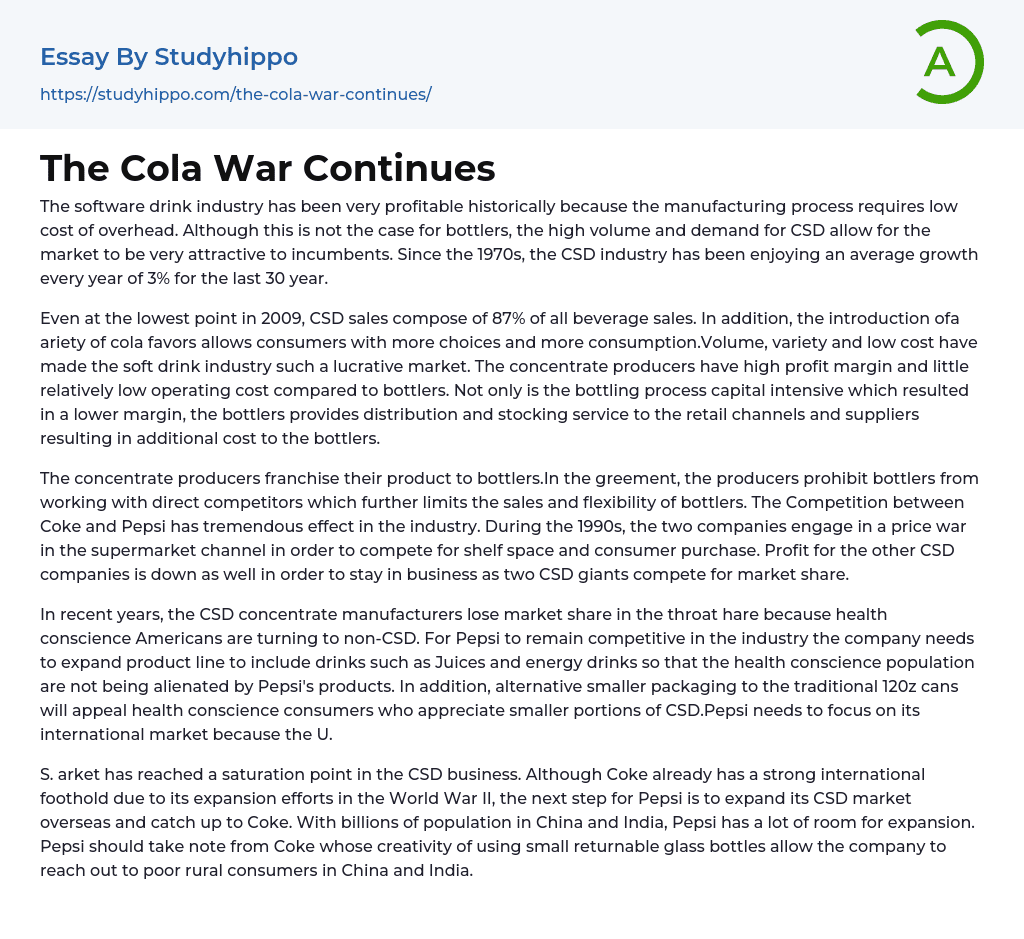Historically, the software drink industry has been lucrative due to its low overhead costs in manufacturing. Despite high costs for bottlers, the high demand and volume of CSD make the market appealing for established businesses. In the past 30 years, the CSD industry has seen steady growth averaging 3% annually since the 1970s.
Despite reaching its lowest point in 2009, CSD sales still accounted for an astounding 87% of all beverage sales. This industry has been highly lucrative due to the combination of volume, variety, and affordability. The introduction of diverse cola flavors has offered consumers more choices and subsequently increased consumption. In terms of profitability, concentrate producers have enjoyed substantial profit margins and relatively low operating costs compared to bottlers.
On the other hand, bottlers encounter additional expenses as a result of the capital-intensive bottling process, leading to lower p
...rofit margins. Additionally, bottlers must provide distribution and stocking services to retail channels and suppliers which incurs supplementary costs.
The franchisors of concentrate restrict bottlers from partnering with direct competitors, resulting in sales and flexibility limitations for the latter. This is especially important given the fierce rivalry between Coke and Pepsi, which significantly affects the industry. During the 1990s, these two companies engaged in a price war in supermarkets to secure consumer purchases and shelf space. In order to compete with such giants and maintain their own market share, other carbonated soft drink firms had to reduce their profits.
Recently, manufacturers of carbonated soft drink (CSD) have been losing market share in the throat hare due to the increasing number of health-conscious Americans turning to non-CSD drinks. To remain competitive, Pepsi must expand its product line by including
healthier drink options such as juices and energy drinks. Additionally, offering alternative smaller packaging to the traditional 12oz cans will appeal to those health-conscious consumers who prefer smaller portions of CSDs. As such, Pepsi should focus on its international market as well as the US.
Pepsi should focus on expanding its CSD market overseas to catch up to Coke. The CSD business has reached a saturation point in the market, but with billions of people in China and India, there is still room for growth. Coke has a strong international presence due to its post-World War II expansion, and Pepsi can learn from their creative use of small returnable glass bottles to reach out to poor rural consumers in those countries.
- World War I essays
- World War Ii essays
- Atomic Bomb essays
- American Civil War essays
- Attack essays
- Cold War essays
- Crimean War essays
- Emilio Aguinaldo essays
- Iraq War essays
- Korean War essays
- Nazism essays
- Nuclear Weapon essays
- Philippine Revolution essays
- Trench Warfare essays
- Vietnam War essays
- Western Front essays
- Diplomacy essays
- Emperor essays
- Rwanda essays
- Tribe essays
- Revolutionary War essays
- War of 1812 essays
- Mexican American War essays
- Hitler essays
- The Spanish American War essays
- League Of Nations essays
- Battle Of The Somme essays
- Treaty Of Versailles essays
- Fascism essays
- D-day essays
- Atomic Physics essays
- Atomic Bombings Of Hiroshima And Nagasaki essays
- Electron essays
- Adidas essays
- Amazon essays
- Apple essays
- Bmw essays
- British Airways essays
- Burger King essays
- Coca-Cola essays
- Company essays
- Costco essays
- Dell essays
- Ebay essays
- Enron essays
- Facebook essays
- Ford Motor Company essays
- Gap essays
- General Motors essays
- Google essays




